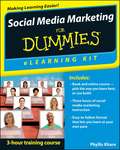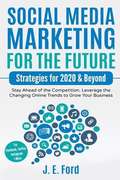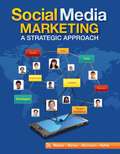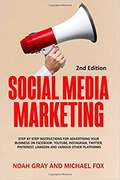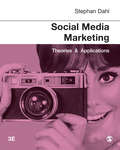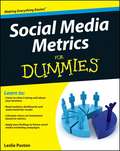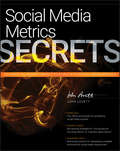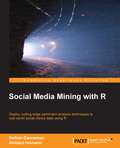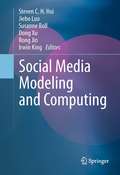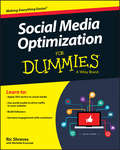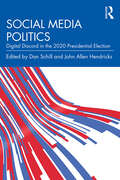- Table View
- List View
Social Media Marketing
by Tracy L. TutenThe original, bestselling, and award-winning textbook on social media marketing, featuring all the essential topics, concepts, research, and practical application for study and career success. Now thoroughly updated in this fifth edition to reflect the latest developments in social media marketing research and practice, and with new case studies and examples, including brands such as Apple, Cadbury, LUSH Cosmetics and Zoom. A must-read for all students and practitioners of social media marketing. Tracy L. Tuten is a professor of marketing at Sofia University, USA.
Social Media Marketing All-in-One For Dummies
by Jan Zimmerman Deborah NgLearn the latest social media marketing techniquesSocial media continues to evolve at breakneck speed, and the savvy marketer needs to keep up. This bestselling guide to social media marketing has been completely updated to cover the newest vehicles, including Groupon and Rue La La, location-based services like Foursquare, and new social networking sites like Google+ and Pinterest. Checklists, case studies, and examples will help you decide the best places to spend your marketing dollars, and you'll learn about valuable social media tools and analytics methods that can help you assess the success of your efforts.A completely updated, all-in-one guide to social media marketing, a valuable way for businesses to reach current and new customers, assist customers with problems, and complete transactionsCovers the latest sites and location-based services including Groupon, Rue La La, Foursquare, Google+, Pinterest, and moreMinibooks examine the social media mix; tools and techniques; using content to grow your brand; Twitter, Facebook, Pinterest, and Google+ marketing; other sites; and how to measure results and build on successThe perfect guidebook for the social media strategist, website manager, marketer, publicist, or anyone in charge of implementing and managing an organization's social media strategySocial Media Marketing All-in-One For Dummies, 2nd Edition helps you get the most from every minute and dollar you spend on marketing.
Social Media Marketing All-in-One For Dummies
by Jan Zimmerman Deborah NgThe bestselling social media marketing book Marketing your business through social media isn't an option these days—it's absolutely imperative. In this new edition of the bestselling Social Media Marketing All-in-One For Dummies, you'll get comprehensive, expert guidance on how to use the latest social media platforms to promote your business, reach customers, and thrive in the global marketplace. Social media continues to evolve at breakneck speed, and with the help of this guide, you'll discover how to devise and maintain a successful social media strategy, use the latest tactics for reaching your customers, and utilize data to make adjustments to future campaigns and activities. Plus, you'll find out how to apply the marketing savvy you already have to the social media your prospects are using, helping you to reach—and keep—more customers, make more sales, and boost your bottom line. Includes the latest changes to Facebook, Twitter, Pinterest, LinkedIn, YouTube, and more Offers tips for engaging your community and measuring your efforts Explains how to blend social media with your other online and offline marketing efforts Shows you how to leverage data to learn more about your community Don't get left behind! Let this book help you get the most from every minute and dollar you spend on marketing.
Social Media Marketing All-in-One For Dummies
by Jan Zimmerman Deborah Ng Michelle KrasniakGet social with the bestselling social media marketing book No person can ignore social media these days—and no business can afford to ignore it either. Our lives are mediated through the flicker of Facebook, Twitter, YouTube, and Instagram—and brands are increasingly interwoven with our online identities. Even for the 90% of marketers who interact with social media regularly, its pace and scale can be confusing to the point of distraction. Social Media Marketing All-in-One For Dummies helps you take a step back, make sense of the noise, and get your brand voice heard over the babble—in the way you want it to be. These nine mini-books in one give you essential, straightforward, and friendly guidance on how to use the major social platforms to promote your business, engage your customers, and use feedback to make your product or service the best that it can be. From evaluating the right social mix and planning your strategy to the really fun stuff—like creating videos on Snapchat and TikTok, diving deep on a podcast, or looking pretty on Pinterest—you’ll find everything you need to get your social ducks in a row and say the right things. And once the campaign is over, you can follow the guidance here to evaluate success and iterate on your approach, before getting right back out there for an even bigger second bite. Keep up with the latest changes on Twitter, Facebook, LinkedIn, TikTok, and more Blend your social side with your traditional marketing presence Become more engaging and metric your success Get to know your fans with user data Wherever you’re coming from—social media strategist, site manager, marketer, or something else—social media is where your customers are. This book shows you how to be there, too.
Social Media Marketing All-in-One For Dummies
by Michelle KrasniakShare your brand message and connect with your customers There's no way around it—social media is everywhere, and the savviest businesses are making the most of it. With the help of Social Media Marketing All-in-One For Dummies, you, too, can join the digital era and take your social media accounts to the next level. Accessible and comprehensive, this guide teaches you to apply your marketing skills to the latest social media platforms, allowing you to promote your business, reach customers, and thrive in the global marketplace. Get up to date with information on AI tools and AI-generated content, as well as voice search, short-form video content, and more. Let this Dummies book coach you to social media marketing success. Get acquainted with the top social media platforms for business marketing Learn how to create more compelling content—with or without the help of AI Consider social commerce and influencer partnerships in your marketing mix Use groups, communities, and private spaces to build trust and camaraderie This nine-in-one guide is perfect for social media strategists, web site managers, marketers, publicists, and anyone else in charge of an organization's social media strategy. It's also a great choice for entrepreneurs interested in learning how social media can help generate business.
Social Media Marketing Workbook: How to Use Social Media for Business
by Jason McDonaldLearn SOCIAL MEDIA MARKETING in Plain English - Step by Step! Buy the Social Media Book Used by Stanford Continuing Studies to Teach Social Media Marketing. Updated - Fully updated for 2024, including the concepts of "Recommendation Engines" vs. "Traditional" social media. Social Media Marketing explained. It's a PARTY and you are the PARTY THROWER. Platform-by-Platform - Step-by-step Marketing on Facebook, Instagram, TikTok, LinkedIn, YouTube, X (Twitter), Pinterest. Read the Reviews - compare the REAL REVIEWS of this book compared to the REVIEWS (?) of other books Learn to Advertise on Social Media Platforms without losing money Watch Videos - view step-by-step companion VIDEOS that SHOW you how to use social media for your business. Use the Worksheets - download WORKSHEETS that guide you step-by-step for EACH platform - Facebook, Twitter, Instagram, YouTube, LinkedIn, etc. Access Free Tools - access the companion Marketing Almanac with free tools for social media marketing! The #1 Bestselling Book on Social Media Marketing for Your Business Jason McDonald - written by a successful practitioner of Social Media Marketing Stanford University - used by Dr. McDonald in his courses, both online and in face-to-face workshops Got Questions? - just Google 'Jason McDonald' and send a quick email or call.
Social Media Marketing and Customer-Based Brand Equity for Higher Educational Institutions: Case of Vietnam and Sri Lanka
by Rajkishore Nayak Charitha Harshani Perera Long Van NguyenThis book examines the extent to which social media marketing influences the customer-based brand equity of higher education institutes. Higher education institutions operate in a strong competitive environment due to the homogenous nature of their services and always look for new marketing strategies to be competitive in the marketplace. Therefore, building customer-based brand equity has become crucial for higher education institutions to differentiate themselves from others to attract prospective students. Social media-based marketing facilitated prospective students to communicate and collaborate to gather information relevant to higher education institutions and their respective brand equity. However, many models on customer-based brand equity received limited support in the higher education sector, particularly in emerging Asian countries. As such, drawing from social information processing theory, this book empirically investigates how higher education institutions can develop customer-based brand equity by using social media marketing and subjective norms mediated by brand credibility, taking cross-country comparisons between Sri Lanka and Vietnam. The book goes on to examine the applications and implications of the findings for higher education institutions in developing branding strategies through social media.
Social Media Marketing eLearning Kit For Dummies
by Phyllis KhareValuable kit teaches social media marketing to learners of all levels If you want to master social media marketing, this valuable eLearning kit is just the ticket. This integrated course includes a full-color printed book and a Dummies interactive eLearning course on CD. You'll find a wealth of information and multiple ways to learn, including practice labs, videos, animation, numerous examples, and a host of Dummies hints and tips that make everything easier. Follow the material in order or jump in and out as you wish--you can learn at your own pace. Helps self-motivated learners master social media marketing Includes an easy-to-follow, full-color book; an interactive Dummies eLearning Course on CD that corresponds with the book Highlights material with integrated audio and video instruction on CD that helps you learn via animations, screencasts, and more Allows you to follow the material sequentially or choose separate sections at your own time and pace Offers chapter summaries, practice exercises, discussions of concepts and essential terms, and much more Social media marketing is a big topic and essential to today's marketplace. Get the skills and knowledge you need with Social Media Marketing eLearning Kit For Dummies. CD-ROM/DVD and other supplementary materials are not included as part of the e-book file, but are available for download after purchase.
Social Media Marketing for Book Publishers
by Miriam J. Johnson Helen A. SimpsonProviding a concise toolbox for publishing professionals and students of publishing, this book explores the skills needed to master the key elements of social media marketing and therefore stay relevant in this ever-competitive industry. Taking a hands-on, practical approach, Social Media Marketing for Book Publishers covers topics including researching and identifying actionable insights, developing a strategy, producing content, promotion types, community building, working with influencers, and how to measure success. Pulling from years of industry experience, the authors’ main focus is on adult fiction publishing, but they also address other areas of the industry including children’s, young adult (YA), academic, and non-fiction. The book additionally brings in valuable voices from the wider digital marketing industries, featuring excerpts from interviews with experts across search engine optimisation (SEO), AdWords, social platforms, community management, influencer management, and content strategists. Social Media Marketing for Book Publishers is a key text for any publishing courses covering how to market books, and should find a place on every publishers' bookshelf.
Social Media Marketing for Business: Scaling an Integrated Social Media Strategy Across Your Organization
by Andrew JenkinsSocial media has become an imperative for almost every business. Discover how to successfully implement an effective social media strategy that is supported and integrated throughout every part of your organization, with this essential handbook to enhancing your online presence. Social Media Marketing for Business provides a step-by-step roadmap to setting up effective workflows, team configurations, governance models and social media policies, alongside creating and measuring content and social media campaigns that have the competitive edge. Featuring insights from leading industry experts, it covers areas such as balancing social media ownership, measuring success using analytics and conducting a social media audit. Containing an array of international case study examples from organizations such as The World Wildlife Fund (WWF), Deloitte Digital, Dell, Burger King and LVMH, Social Media Marketing for Business explores how to build a supportive culture, get buy-in and the common pitfalls to avoid. Supported by a content calendar templates, content marketing framework and online presentation slides, this book is a one-stop-shop for developing effective social media marketing strategies and integrating them within your business.
Social Media Marketing for the Future: Strategies for 2020 and Beyond
by J. E. Ford<p>Social media marketing is not an option anymore. Your customers—no matter who they are—expect you to reach them the way they communicate. The vast majority of companies have inadequate social media marketing strategies. Most companies are playing catch-up with current digital marketing trends and their strategies will be outdated by the time the company has mastered them. <p>To successfully market on social media, you need to be prepared for the future. Social media changes rapidly and frequently. <p>This book will teach you: <p> <li>The most important social media trends to expect for the next years and beyond <li>How to apply perennial marketing principles to new mediums and technologies <li>How to understand and reach new customer profiles and the new generation of social media: Gen Z <li>New government regulation and privacy trends that will affect your marketing efforts</li> <p> <p>This book discusses: <p> <li>The future of Facebook, Instagram, Twitter, Snapchat, YouTube and more, and how to harness their power to build your brand and gain customers <li>New social networks that are on the rise and may become major contenders <li>Technological trends that are redefining the rhythm of social media <li>How to utilize new technology and tools to strengthen your brand and achieve a competitive edge.</li> <p> <p>If your marketing plan is focused only on today’s trends, you’ve already lost. Plan for tomorrow. Beat out the competition. Reach your customers where they are. <p>The future is here. Are you ready?</p>
Social Media Marketing in Tourism and Hospitality
by Roberta MinazziThis book describes ongoing developments in social media within the tourism and hospitality sector, highlighting impacts on both the demand and the supply side. It offers a combination of theory and practice, with discussion of real-life business experiences. The book is divided into three parts, the first of which provides an overview of recent trends in social media and user-generated content, clarifies concepts that are often used in an overlapping way and examines the "digitization of word of mouth" via online networks. The second part analyzes the impacts that social media can have on traveler behavior for each step in the travel process and also on suppliers, highlighting opportunities, threats and strategies. In the third part of the book, future potential trends deriving from the mobile marketing technologies are explored and possible methods for social monitoring by means of key performance indicators are examined. It is considered how engaging customers and prospects by means of social media might increase customer loyalty, foster electronic word-of-mouth communication, and consequently have important effects on corporate sales and revenues. The discussion encompasses methods to measure company performance on each of the social media in order to understand the optimal mix that will support and improve business strategies.
Social Media Marketing: A Strategic Approach
by Melissa Barker Donald I. Barker Nicholas F. Bormann Krista E. NeherSocial Media Marketing: A Strategic Approach promises to be the seminal textbook in the field with its distinctive conceptual foundation and practical approach to developing successful social media marketing plans. A proven eight-step social media planning model provides students with a cumulative learning experience, showing them how to construct social media strategies that achieve desired marketing goals.
Social Media Marketing: Facebook Marketing, Youtube Marketing, Instagram Marketing
by Mark SmithCreate Amazing Business Opportunities And Reach More Followers Using the Power of The Social Media! This Box Set Includes 3 Books - Facebook Marketing, Youtube Marketing, Instagram Marketing.
Social Media Marketing: Step by Step Instructions for Advertising Your Business on Facebook, Youtube, Instagram, Twitter, Pinterest, Linkedin and Various Other Platforms (Second Edition)
by Noah GrayThis book covers a lot of Social Media Platforms: Facebook, Facebook Advertising, Youtube, Instagram, Twitter, Pinterest, Linkedin, Snapchat, Reddit, Tumblr, Quora, Goodreads, Periscope, Flickr, Google Adwords, Google+. If you are ready to improve your business through social media marketing, this book will provide you with everything you need.
Social Media Marketing: Theories and Applications
by Stephan DahlHelping you make the connections between the theory and practice of social media marketing, this third edition of the popular text has been updated to include technological advances in practice such as AI and virtual marketing, alongside a brand-new chapter on the rise of influencer culture and marketing. Examples and case studies throughout help you to contextualise the text through popular brands and platforms such as Instagram, Dunkin Donuts, Amazon and also political marketing for social movements such as Extinction Rebellion. This text is essential reading for all marketing students, researchers and practitioners today.
Social Media Marketing: Theories and Applications
by Stephan DahlHelping you make the connections between the theory and practice of social media marketing, this third edition of the popular text has been updated to include technological advances in practice such as AI and virtual marketing, alongside a brand-new chapter on the rise of influencer culture and marketing. Examples and case studies throughout help you to contextualise the text through popular brands and platforms such as Instagram, Dunkin Donuts, Amazon and also political marketing for social movements such as Extinction Rebellion. This text is essential reading for all marketing students, researchers and practitioners today.
Social Media Marketing: guida definitiva per l'utente su Facebook, Instagram, YouTube, Blogging, Twitter, LinkedIn,
by Adidas WilsonCosa si intende quando si parla di coinvolgimento sui Social Media? La risposta è semplice: è il numero di condivisioni, Mi piace e commenti. Sicuramente, avere un grande seguito è fantastico, ma bisogna ricordare che è sempre meglio puntare alla qualità che alla quantità e un pubblico impegnato è meglio di uno grande. Esistono alcune metriche utilizzate per misurare il coinvolgimento sui Social Media tra i quali: l’uso di hashtag brandizzati, le menzioni, i click-through, la crescita dei follower, i “Mi piace”, i Commenti, i Retweet e le condivisioni. I tuoi follower possono iniziare a interagire con i tuoi contenuti in maniera naturale. Ma spesso, potresti dover incoraggiarli un po'. Ci sono alcuni trucchi che possono aiutarti a raggiungere tale obiettivo. Valuta il tuo coinvolgimento: guarda quanti follower hai, il numero medio di condivisioni e commenti che ricevi su ogni post e qualsiasi altro numero rilevante. Assicurati di continuare a monitorare questi numeri. Scegli la tua strategia: ogni azienda ha obiettivi diversi e le strategie sono, quindi, diverse. La tua strategia dipenderà dai tuoi obiettivi. Potrebbe essere educare il pubblico, raccogliere feedback, cambiare la percezione del pubblico, ecc. Comprendi il tuo pubblico: non è facile coinvolgere persone che non conosci.
Social Media Metrics For Dummies
by Leslie PostonDiscover how to gauge your online success based on social media metricsWith so many social media monitoring and measurement tools available, it can be overwhelming to figure out which tool is right for you when it comes to calculating the success of your social media marketing efforts. This fun and friendly guide helps you determine which tool will serve you best for understanding your online audience.You'll learn to sift through all the information available about social media monitoring and metrics so that you can listen to what is being said about your business, read your analytic dashboard, understand what metrics mean for you, calculate your return on investment (ROI), and apply your findings to future social media marketing campaigns.Helps you wade through the plethora of social media monitoring and metrics to discover what elements are most applicable to your needsExplains the meaning behind the social media metrics tools so that you can understand how to make those results work for youShares examples of how to calculate both the financial and non-financial return on investment of your social media effortsIncludes real-world case studies that demonstrate how small and large businesses are using social media metricsWith this helpful book by your side, you will learn how to understand the information you acquire regarding your social media marketing efforts and then put that information to work for your business.
Social Media Metrics Secrets
by John LovettInvaluable advice on analyzing and measuring the effects of social mediaDo you wish you could sit down with an expert to figure out whether or not your social media initiatives are working? With Social Media Metrics Secrets, you can! Expert John Lovett taps into his years of training and experience to reveal tips, tricks, and advice on how to analyze and measure the effects of social media and gauge the success of your initiatives. He uses mini case studies to demonstrate how to manage social operations with process and technology by applying key performance indicators, and assessing the business value of social media.Highlights how social media can impact all aspects of your business and transform the way you quantify successful interactions with customers Shares innovative techniques for managing the massive volume of social analytics data by putting data to work in ways that contribute to your organizational goals Details techniques for adopting a Social Analytics Framework for understanding evolving consumer behavior necessary to compete in a socially networked future Written in a conversational tone, Social Media Metrics Secrets goes behind the scenes to present you with unbeatable advice and unparalleled insight into social media metrics.
Social Media Mining
by Reza Zafarani Mohammad Ali Abbasi Huan LiuSocial media shatters the barrier to communicate anytime anywhere for people of all walks of life. The publicly available, virtually free information in social media poses a new challenge to consumers who have to discern whether a piece of information published in social media is reliable. For example, it can be difficult to understand the motivations behind a statement passed from one user to another, without knowing the person who originated the message. Additionally, false information can be propagated through social media, resulting in embarrassment or irreversible damages. Provenance data associated with a social media statement can help dispel rumors, clarify opinions, and confirm facts. However, provenance data about social media statements is not readily available to users today. Currently, providing this data to users requires changing the social media infrastructure or offering subscription services. Taking advantage of social media features, research in this nascent field spearheads the search for a way to provide provenance data to social media users, thus leveraging social media itself by mining it for the provenance data. Searching for provenance data reveals an interesting problem space requiring the development and application of new metrics in order to provide meaningful provenance data to social media users. This lecture reviews the current research on information provenance, explores exciting research opportunities to address pressing needs, and shows how data mining can enable a social media user to make informed judgements about statements published in social media. Table of Contents: Information Provenance in Social Media / Provenance Attributes / Provenance via Network Information / Provenance Data
Social Media Mining with R
by Nathan Danneman Richard HeimannA concise, hands-on guide with many practical examples and a detailed treatise on inference and social science research that will help you in mining data in the real world. Whether you are an undergraduate who wishes to get hands-on experience working with social data from the Web, a practitioner wishing to expand your competencies and learn unsupervised sentiment analysis, or you are simply interested in social data analysis, this book will prove to be an essential asset. No previous experience with R or statistics is required, though having knowledge of both will enrich your experience.
Social Media Modeling and Computing
by Susanne Boll Irwin King Jiebo Luo Rong Jin Dong Xu Steven C.H. HoiThis timely text/reference presents the latest advances in various aspects of social media modeling and social media computing research. Gathering together superb research from a range of established international conferences and workshops, the editors coherently organize and present each of the topics in relation to the basic principles and practices of social media modeling and computing. Individual chapters can be also be used as self-contained references on the material covered. Topics and features: presents contributions from an international selection of preeminent experts in the field; discusses topics on social-media content analysis; examines social-media system design and analysis, and visual analytic tools for event analysis; investigates access control for privacy and security issues in social networks; describes emerging applications of social media, for music recommendation, automatic image annotation, and the analysis and improvement of photo-books.
Social Media Optimization For Dummies
by Ric Shreves Michelle KrasniakOptimize, optimize, optimize to get the most out of your company's social media presence As it turns out, social media is good for a lot more than funny cat videos, memes, and sharing what you're eating for lunch with the world. As the social media sphere continues to grow and be redefined, it's more important than ever to arm yourself with the latest information on how you can use it to drive traffic to your website, raise awareness of your brand, and promote your products or services. If you're a marketer who has asked yourself how you can possibly stay afloat in these newly chartered and oft overcrowded waters, Social Media Optimization For Dummies serves as your roadmap to smart marketing in the digital age. So, what is Social Media Optimization (SMO), exactly? Well, it's comprised of two closely related practices. First, SMO refers to a set of techniques in which social media is used to drive traffic to a website and create an interest in a product or service. Second, SMO concerns the optimization of the social media presence itself with the goal of building followers, increasing engagement, and, again, generating interest in a product or service. Each of these parts supports the other and, when the channels are managed efficiently, enhances the other's effectiveness. In this plain English, easy-to-follow guide, you'll quickly discover how to apply SMO practices to your marketing plan to accomplish those goals. Integrate social media into your website Drive traffic to your website Build followers and generate a buzz Increase engagement with customers From integrating social media into your website to building your social media presence to everything in between, Social Media Optimization For Dummies points your business toward success.
Social Media Politics: Digital Discord in the 2020 Presidential Election
by John Allen Hendricks Dan SchillSocial media and social networking services are integrated into the American political process and have profoundly influenced political communication and participation. Social media platforms have transformed the political landscape by revolutionizing information dissemination, citizen engagement, and public opinion formation and change. Politicians use social media to communicate directly with voters in an unmediated and unfiltered manner. Comparatively, voters use social media to follow the latest messaging from politicians accompanied by demonstrating their support for particular politicians. This book is a comprehensive examination of the role of digital and social media in the 2020 U.S. presidential election. Political discourse during the 2020 election revealed political disharmony and a deep political division among vast swaths of Americans that was powered, in part, by social media. This book reveals how digital and social media have reshaped power dynamics by altering the relationships among citizens, politicians, and traditional media outlets, the emergence of new influencers, and the impact of online activism on policy agendas.This book, Social Media Politics, includes scholars with varied backgrounds and experience, using both quantitative and qualitative methodologies, from leading research institutions around the nation. Students, scholars, and practitioners will gain new knowledge to more clearly understand the role social media played in the 2020 presidential campaign.







